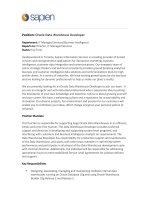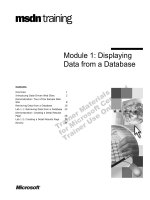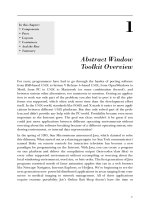1 Oracle Data Guard: Overview
Bạn đang xem bản rút gọn của tài liệu. Xem và tải ngay bản đầy đủ của tài liệu tại đây (128.62 KB, 17 trang )
1
Copyright © 2006, Oracle. All rights reserved.
Oracle Data Guard: Overview
Copyright © 2006, Oracle. All rights reserved.
1 - 2
Objectives
After completing this lesson, you should be able to do the
following:
•
Describe the factors that affect planned and unplanned
downtime
•
Describe the basic components of Oracle Data Guard
•
Explain the differences between physical and logical
standby databases
•
Explain the benefits of creating a Data Guard
environment
•
Explain the use of Data Guard in high-availability
architectures
Copyright © 2006, Oracle. All rights reserved.
1 - 3
Causes of Data Loss
Source: Disaster Recovery Journal
Natural disasters
3%
Software corruption
4%
Computer viruses 7%
Human errors
36%
Hardware & system errors 49%
Copyright © 2006, Oracle. All rights reserved.
1 - 4
Understanding the Causes of Downtime
Planned
downtime
Unplanned
downtime
System
changes
Data
changes
Data
failures
Computer
failures
Corruption
Human
error
Site
failure
Storage
failure
Copyright © 2006, Oracle. All rights reserved.
1 - 5
What Is Oracle Data Guard?
Primary
database
Standby
database
Database Database
copy
Redo transport
Oracle Net
Copyright © 2006, Oracle. All rights reserved.
1 - 6
Types of Standby Databases
There are two types of standby databases:
•
Physical standby database
–
Identical to the primary database on a block-for-block
basis
–
Synchronized with the primary database through
application of redo data received from the primary
database
•
Logical standby database
–
Shares the same schema definition
–
Synchronized with the primary database by transforming
the data in the redo received from the primary database
into SQL statements and then executing the SQL
statements









